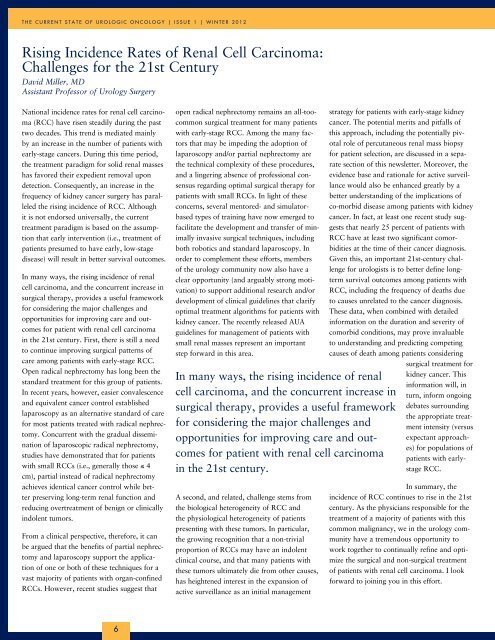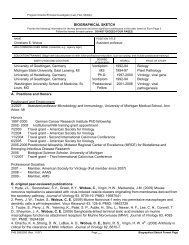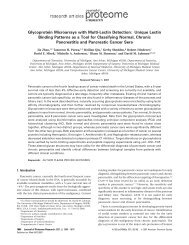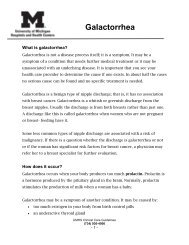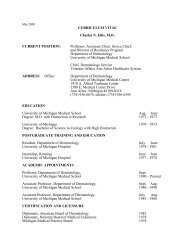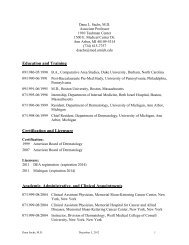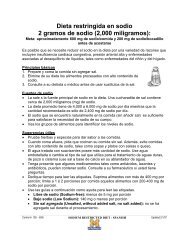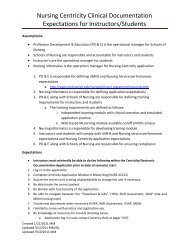uRoloGIC onColoGy - University of Michigan Health System
uRoloGIC onColoGy - University of Michigan Health System
uRoloGIC onColoGy - University of Michigan Health System
You also want an ePaper? Increase the reach of your titles
YUMPU automatically turns print PDFs into web optimized ePapers that Google loves.
The CurrenT STaTe <strong>of</strong> urologiC onCology | iSSue 1 | winTer 2012<br />
rising incidence rates <strong>of</strong> renal cell carcinoma:<br />
challenges for the 21st century<br />
David Miller, MD<br />
Assistant Pr<strong>of</strong>essor <strong>of</strong> Urology Surgery<br />
national incidence rates for renal cell carcinoma<br />
(rcc) have risen steadily during the past<br />
two decades. this trend is mediated mainly<br />
by an increase in the number <strong>of</strong> patients with<br />
early-stage cancers. During this time period,<br />
the treatment paradigm for solid renal masses<br />
has favored their expedient removal upon<br />
detection. consequently, an increase in the<br />
frequency <strong>of</strong> kidney cancer surgery has paralleled<br />
the rising incidence <strong>of</strong> rcc. Although<br />
it is not endorsed universally, the current<br />
treatment paradigm is based on the assumption<br />
that early intervention (i.e., treatment <strong>of</strong><br />
patients presumed to have early, low-stage<br />
disease) will result in better survival outcomes.<br />
in many ways, the rising incidence <strong>of</strong> renal<br />
cell carcinoma, and the concurrent increase in<br />
surgical therapy, provides a useful framework<br />
for considering the major challenges and<br />
opportunities for improving care and outcomes<br />
for patient with renal cell carcinoma<br />
in the 21st century. first, there is still a need<br />
to continue improving surgical patterns <strong>of</strong><br />
care among patients with early-stage rcc.<br />
open radical nephrectomy has long been the<br />
standard treatment for this group <strong>of</strong> patients.<br />
in recent years, however, easier convalescence<br />
and equivalent cancer control established<br />
laparoscopy as an alternative standard <strong>of</strong> care<br />
for most patients treated with radical nephrectomy.<br />
concurrent with the gradual dissemination<br />
<strong>of</strong> laparoscopic radical nephrectomy,<br />
studies have demonstrated that for patients<br />
with small rccs (i.e., generally those ≤ 4<br />
cm), partial instead <strong>of</strong> radical nephrectomy<br />
achieves identical cancer control while better<br />
preserving long-term renal function and<br />
reducing overtreatment <strong>of</strong> benign or clinically<br />
indolent tumors.<br />
from a clinical perspective, therefore, it can<br />
be argued that the benefits <strong>of</strong> partial nephrectomy<br />
and laparoscopy support the application<br />
<strong>of</strong> one or both <strong>of</strong> these techniques for a<br />
vast majority <strong>of</strong> patients with organ-confined<br />
rccs. However, recent studies suggest that<br />
6<br />
open radical nephrectomy remains an all-toocommon<br />
surgical treatment for many patients<br />
with early-stage rcc. Among the many factors<br />
that may be impeding the adoption <strong>of</strong><br />
laparoscopy and/or partial nephrectomy are<br />
the technical complexity <strong>of</strong> these procedures,<br />
and a lingering absence <strong>of</strong> pr<strong>of</strong>essional consensus<br />
regarding optimal surgical therapy for<br />
patients with small rccs. in light <strong>of</strong> these<br />
concerns, several mentored- and simulatorbased<br />
types <strong>of</strong> training have now emerged to<br />
facilitate the development and transfer <strong>of</strong> minimally<br />
invasive surgical techniques, including<br />
both robotics and standard laparoscopy. in<br />
order to complement these efforts, members<br />
<strong>of</strong> the urology community now also have a<br />
clear opportunity (and arguably strong motivation)<br />
to support additional research and/or<br />
development <strong>of</strong> clinical guidelines that clarify<br />
optimal treatment algorithms for patients with<br />
kidney cancer. the recently released AUA<br />
guidelines for management <strong>of</strong> patients with<br />
small renal masses represent an important<br />
step forward in this area.<br />
in many ways, the rising incidence <strong>of</strong> renal<br />
cell carcinoma, and the concurrent increase in<br />
surgical therapy, provides a useful framework<br />
for considering the major challenges and<br />
opportunities for improving care and outcomes<br />
for patient with renal cell carcinoma<br />
in the 21st century.<br />
A second, and related, challenge stems from<br />
the biological heterogeneity <strong>of</strong> rcc and<br />
the physiological heterogeneity <strong>of</strong> patients<br />
presenting with these tumors. in particular,<br />
the growing recognition that a non-trivial<br />
proportion <strong>of</strong> rccs may have an indolent<br />
clinical course, and that many patients with<br />
these tumors ultimately die from other causes,<br />
has heightened interest in the expansion <strong>of</strong><br />
active surveillance as an initial management<br />
strategy for patients with early-stage kidney<br />
cancer. the potential merits and pitfalls <strong>of</strong><br />
this approach, including the potentially pivotal<br />
role <strong>of</strong> percutaneous renal mass biopsy<br />
for patient selection, are discussed in a separate<br />
section <strong>of</strong> this newsletter. moreover, the<br />
evidence base and rationale for active surveillance<br />
would also be enhanced greatly by a<br />
better understanding <strong>of</strong> the implications <strong>of</strong><br />
co-morbid disease among patients with kidney<br />
cancer. in fact, at least one recent study suggests<br />
that nearly 25 percent <strong>of</strong> patients with<br />
rcc have at least two significant comorbidities<br />
at the time <strong>of</strong> their cancer diagnosis.<br />
Given this, an important 21st-century challenge<br />
for urologists is to better define longterm<br />
survival outcomes among patients with<br />
rcc, including the frequency <strong>of</strong> deaths due<br />
to causes unrelated to the cancer diagnosis.<br />
these data, when combined with detailed<br />
information on the duration and severity <strong>of</strong><br />
comorbid conditions, may prove invaluable<br />
to understanding and predicting competing<br />
causes <strong>of</strong> death among patients considering<br />
surgical treatment for<br />
kidney cancer. this<br />
information will, in<br />
turn, inform ongoing<br />
debates surrounding<br />
the appropriate treatment<br />
intensity (versus<br />
expectant approaches)<br />
for populations <strong>of</strong><br />
patients with earlystage<br />
rcc.<br />
in summary, the<br />
incidence <strong>of</strong> rcc continues to rise in the 21st<br />
century. As the physicians responsible for the<br />
treatment <strong>of</strong> a majority <strong>of</strong> patients with this<br />
common malignancy, we in the urology community<br />
have a tremendous opportunity to<br />
work together to continually refine and optimize<br />
the surgical and non-surgical treatment<br />
<strong>of</strong> patients with renal cell carcinoma. i look<br />
forward to joining you in this effort.


